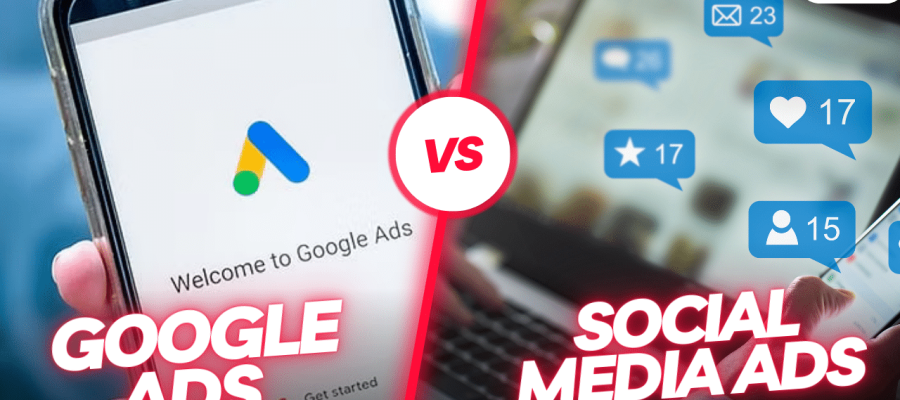Google Ads vs. Social Media Ads: Which is Better for Your Business?
When it comes to digital advertising, businesses are often faced with a choice: Google Ads or social media ads? Both platforms offer powerful ways to reach target audiences, but each has distinct advantages depending on your goals, industry, and audience. In this guide, we’ll explore the differences between Google Ads and social media ads to help you decide which is better for your business.

1. Understanding Google Ads
Google Ads, also known as pay-per-click (PPC) advertising, allows businesses to display ads on Google’s search engine results pages (SERPs) and across its display network. With Google Ads, you can bid on specific keywords related to your business, and your ads appear when users search for those keywords.
Advantages of Google Ads:
- Search Intent: Google Ads target users based on search intent. This means your ad appears when someone is actively searching for a product or service, making them more likely to convert.
- High Visibility: Google is the world’s largest search engine, handling billions of searches daily. This gives you access to a vast audience.
- Precise Targeting: Google Ads offers precise targeting options based on location, device, time of day, and even specific keywords. This ensures your ads reach the right people at the right time.
- Measurable Results: With Google Ads, you can track clicks, impressions, conversions, and other metrics in real-time, allowing for easy optimization and performance tracking.
Best for:
- Businesses with a clear set of keywords to target.
- Companies looking for high-intent users who are ready to make a purchase.
- E-commerce, local businesses, and services like legal, medical, or consulting.
2. Understanding Social Media Ads
Social media ads allow businesses to advertise on platforms like Facebook, Instagram, Twitter, LinkedIn, and TikTok. These platforms offer a wide range of ad formats, including image ads, video ads, and carousel ads, designed to engage users in their social feeds.
Advantages of Social Media Ads:
- Audience Targeting: Social media platforms allow you to target users based on their demographics, interests, behavior, and even engagement with your brand. You can reach highly specific audience segments, making it ideal for niche markets.
- Engagement and Brand Awareness: Social media ads are great for building brand awareness and fostering engagement. Users are more likely to interact with your brand through likes, comments, and shares.
- Visual and Creative Flexibility: Social media ads allow for more creative freedom with visuals and storytelling, making it ideal for brands that rely on visual appeal, such as fashion, beauty, or lifestyle products.
- Cost-Effective for Brand Building: Social media ads are often cheaper than Google Ads when it comes to cost-per-click (CPC), especially when focusing on engagement and brand awareness rather than direct conversions.
Best for:
- Brands aiming to build relationships and increase brand visibility.
- Companies targeting specific demographics or interests.
- Products and services that benefit from visual marketing, like fashion, food, or travel.
3. Key Differences Between Google Ads and Social Media Ads
Search vs. Discovery: Google Ads targets users based on what they’re actively searching for, while social media ads target users based on interests and behavior. If you want to capture users at the moment of intent (like when they search for “best running shoes”), Google Ads may be more effective. On the other hand, if you want to introduce your brand to potential customers who may not be actively searching for your product but are likely to be interested, social media ads are a better fit.
Cost Structure: Google Ads generally operate on a pay-per-click model, while social media ads can be priced based on impressions, engagement, or clicks. While social media ads might be more cost-effective for building awareness, Google Ads often provide a better return on investment (ROI) for conversion-driven campaigns.
Audience Engagement: Social media platforms allow for more direct interaction with users through comments, likes, and shares. This can create a sense of community and loyalty. Google Ads, on the other hand, are more transactional and less focused on engagement.
4. Choosing the Right Platform for Your Business
Ultimately, the decision between Google Ads and social media ads depends on your business objectives:
If you need immediate conversions (such as online sales or lead generation), and your target audience is actively searching for your product or service, Google Ads is likely a better choice.
If your goal is brand awareness, engagement, or long-term relationship building, and you’re targeting a specific demographic or interest group, social media ads offer more flexibility and engagement potential.
5. Why Not Use Both?
In many cases, a hybrid approach that leverages both Google Ads and social media ads can be the most effective strategy. Google Ads can capture users with high purchase intent, while social media ads build brand awareness and engagement. This multi-channel approach ensures that your brand remains visible throughout the entire customer journey, from discovery to conversion.
Conclusion
Choosing between Google Ads and social media ads depends on your business goals, target audience, and budget. Google Ads are ideal for targeting high-intent users ready to take action, while social media ads are excellent for building relationships and increasing brand visibility. By understanding the strengths and weaknesses of each platform, you can create a digital advertising strategy that drives both traffic and conversions, helping your business grow.
